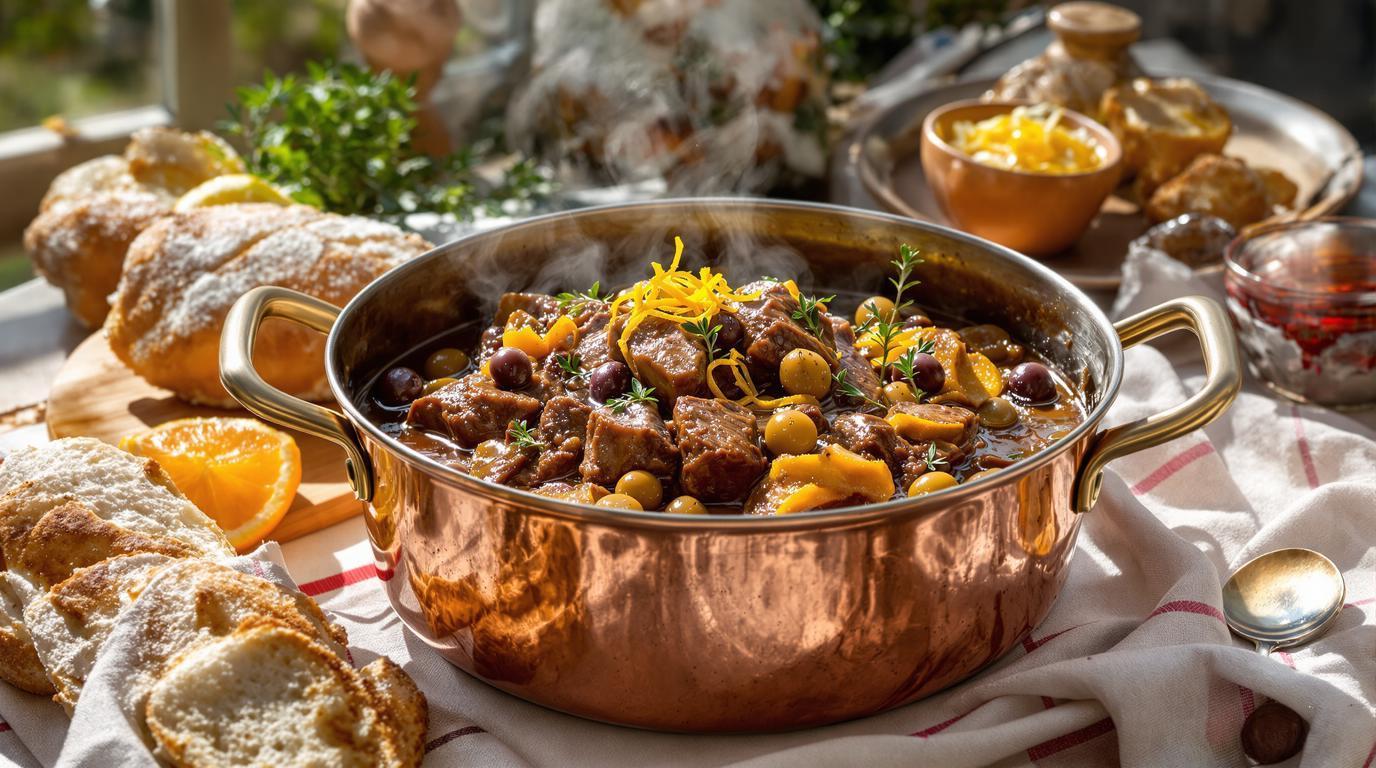The first time I encountered Estouffade Provençale, I was wandering through a tiny village in the Luberon. The aroma drew me into a stone-walled restaurant where an elderly woman was tending to a copper pot. “C’est la recette de ma grand-mère,” she whispered, lifting the lid to reveal chunks of beef swimming in a glossy sauce fragrant with herbs and sweet tomatoes. That first spoonful – tender beef yielding to the gentlest pressure, infused with the essence of Provence – changed how I approach slow-cooking forever. The magic wasn’t in complexity but in patience and respect for ingredients.
The Story 📖
Estouffade Provençale (literally “stifled beef”) comes from the Occitan word “estouffar” meaning “to suffocate” – a poetic description of meat slowly surrendering to a bath of aromatic liquid. This isn’t just another beef stew; it’s a cornerstone of Provençal cuisine where tomatoes, olives, and herbs of the South create a symphony of Mediterranean flavors. Unlike its richer cousin Beef Bourguignon, Estouffade embraces brightness and clarity of flavor rather than depth and richness.
Ingredients Spotlight 🧪
For the base (serves 6):
- 2½ lbs (1.2 kg) beef chuck or short rib, cut into 2-inch cubes
- 2 medium onions, diced (about 2 cups)
- 4-6 garlic cloves, minced
- 2 tbsp tomato paste
- 1 lb (450g) fresh tomatoes, peeled and chopped
- 1 cup Niçoise or Kalamata olives, pitted
- 3 tsp fresh thyme leaves (or 1 tsp dried)
- 2 bay leaves
- 2 cups (500ml) dry white wine (Côtes-du-Rhône blanc works beautifully)
- 1 cup (250ml) beef broth
- 2-3 tbsp olive oil or lard
- Sea salt and freshly cracked pepper
Step-by-Step Guide 📝
1. Prepare the meat: Pat beef cubes completely dry with paper towels – this is non-negotiable for proper browning. Season generously with salt and pepper.
2. Create the foundation: Heat oil in a heavy-bottomed Dutch oven or clay pot (my preference) over medium-high heat until shimmering. Working in batches to avoid overcrowding, sear the beef until deeply browned on all sides, about 3-4 minutes per batch. Transfer to a plate.
3. Build the flavor base: Reduce heat to medium. Add onions to the same pot with a pinch of salt and cook until translucent, about 5 minutes. Add garlic and cook until fragrant, about 30 seconds. Stir in tomato paste and cook for 2 minutes until it darkens slightly and coats the vegetables.
4. Layer the ingredients: Return beef to the pot. Add chopped tomatoes, olives, thyme, and bay leaves.
5. Create the braise: Pour in wine and bring to a simmer, scraping up any browned bits from the bottom of the pot. Let reduce by about one-third (about 5 minutes) before adding broth.
6. Slow cook to perfection: Cover and reduce heat to maintain a gentle simmer. Cook for 2½-3 hours, stirring occasionally, until beef is fork-tender but still holds its shape. Alternatively, place in a 275°F (135°C) oven for the same duration.
7. Finish: Adjust seasoning with salt and pepper. Discard bay leaves. If desired, skim any excess fat from the surface.
Expert Techniques 🛠️
The difference between a good Estouffade and a magnificent one lies in technique. First, never rush the browning process – those caramelized bits are pure flavor gold. Second, the reduction of wine before adding broth concentrates the acidity and aromatics, creating a more balanced foundation.
Chef’s Note: Unlike many stews, Estouffade benefits from being made a day ahead. The flavors meld and deepen overnight, and the texture becomes even more velvety. Simply reheat gently before serving, adding a fresh sprinkle of herbs to brighten.
For a lighter summer version, add diced zucchini and bell peppers in the final 30 minutes of cooking. In winter, a pinch of orange zest and a cinnamon stick create a warming variation that’s especially comforting.
Presentation & Pairing Ideas 🍽️
Serve Estouffade family-style in its cooking vessel for rustic charm, or plate individually with the sauce spooned generously over the meat. While crusty bread is traditional, it also pairs beautifully with soft polenta or roasted fingerling potatoes to soak up the sauce.
For wine, embrace regionality with a Bandol red or Côtes-du-Rhône Villages. If you’ve used white wine in cooking, consider serving the same bottle at the table – the flavor continuity creates a harmonious dining experience.
This dish’s Mediterranean heart makes it perfectly compatible with a simple green salad dressed with olive oil and lemon juice, similar to how you might enjoy a fresh falafel bowl but with deeper flavors.
The final secret to Estouffade isn’t in the recipe at all – it’s in understanding that this dish represents an approach to cooking where time itself becomes an ingredient. Don’t rush it. Let the flavors develop slowly, like a good conversation among friends sharing a table. Make it your own by adjusting the herb balance or olive variety, but always respect the fundamental principle: patience yields transformation.
